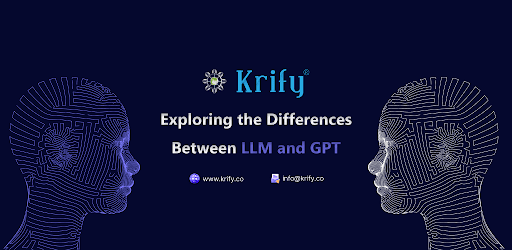In the realm of artificial intelligence, language models play a crucial role in understanding and generating human-like text. Two prominent types of language models that have gained significant attention are LLM (Large Language Models) and GPT (Generative Pre-trained Transformers). While they share similarities in their underlying architectures and capabilities, they also exhibit key differences that are worth exploring. We’ll delve into the distinctions between LLM and GPT to provide a comprehensive understanding of these groundbreaking technologies.
What are LLM and GPT?
LLM:
LLM (Large Language Models) refers to a class of advanced language models that train on vast amounts of text data to understand and generate human-like text. These models find applications across a wide range of areas, such as natural language understanding, text generation, translation, summarization, and more. Their massive size, sophisticated architectures, and ability to handle complex language tasks characterize LLMs.
GPT:
GPT (Generative Pre-trained Transformers) represents a specific type of LLM that OpenAI has developed. These models, based on the transformer architecture, efficiently process and generate text data. Developers pre-train them on a diverse corpus of text data and fine-tune them for specific downstream tasks, making them highly versatile and adaptable to various applications.
Architectural Differences between LLM and GPT
One of the primary differences between LLM and GPT lies in their architectures:
- LLMs encompass a broader category of language models that includes various architectures beyond transformers. While transformers are commonly used in LLMs due to their effectiveness in processing sequential data, other architectures such as LSTM (Long Short-Term Memory) and CNN (Convolutional Neural Networks) may also be employed in LLMs.
- GPT specifically refers to models based on the transformer architecture, which consists of multiple layers of self-attention mechanisms. This architecture enables GPT models to capture long-range dependencies in text data and generate coherent and contextually relevant responses.
Training and Fine-Tuning between LLM and GPT
Another significant distinction between LLM and GPT is their training and fine-tuning processes:
- LLMs undergo extensive pre-training on large-scale text corpora, where they learn to predict the next word in a sequence based on the context provided by preceding words. This pre-training phase helps LLMs acquire a broad understanding of language patterns and structures.
- GPT models are pre-trained using a specific variant of unsupervised learning called self-supervised learning, where they learn to predict masked or corrupted tokens within a sequence. This pre-training phase equips GPT models with the ability to generate coherent and contextually appropriate text.
- Researchers can fine-tune both LLMs and GPT models on task-specific datasets after pre-training to enhance their performance on downstream applications.
Performance and Applications by LLM and GPT
In terms of performance and applications, both LLMs and GPT models excel in various language-related tasks:
- LLMs, with their diverse architectures, can be tailored to specific tasks and domains, making them suitable for a wide range of applications in natural language processing (NLP). They are widely used in areas such as chatbots, virtual assistants, content generation, sentiment analysis, and information retrieval.
- GPT models, specifically designed for text generation tasks, have demonstrated remarkable capabilities in generating human-like text across different genres and styles. They are particularly well-suited for applications such as text completion, storytelling, dialogue generation, and language translation.
Conclusion
In summary, LLMs and GPT models represent two distinct yet interconnected facets of modern language modeling. There fore, LLMs represent a broad class of diverse language models. GPT models are notable for their transformer-based architecture and text generation skills. By grasping the differences between LLM and GPT, researchers and developers can use these tools effectively. They address challenges in natural language understanding and generation. As LLMs and GPT models evolve, their impact on NLP, AI, and human-computer interaction will grow. This advancement will pave the way for more sophisticated applications in the future.
At Krify, we work with the latest AI models, including proprietary and open-source LLMs, and cloud-based AI tools. Our AI and ML engineers employ cutting-edge tools. If you need support developing AI-based mobile apps, agents, or innovative models, contact us. We can harness the power of LLMs and GPT models together. This collaboration will create sophisticated applications that shape the future.



